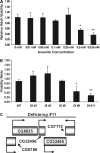Investigating arsenic susceptibility from a genetic perspective in Drosophila reveals a key role for glutathione synthetase
- PMID: 18779381
- PMCID: PMC2639754
- DOI: 10.1093/toxsci/kfn192
Investigating arsenic susceptibility from a genetic perspective in Drosophila reveals a key role for glutathione synthetase
Abstract
Chronic exposure to arsenic-contaminated drinking water can lead to a variety of serious pathological outcomes. However, differential responsiveness within human populations suggests that interindividual genetic variation plays an important role. We are using Drosophila to study toxic metal response pathways because of unrivalled access to varied genetic approaches and significant demonstrable overlap with many aspects of mammalian physiology and disease phenotypes. Genetic analysis (via chromosomal segregation and microsatellite marker-based recombination) of various wild-type strains exhibiting relative susceptibility or tolerance to the lethal toxic effects of arsenite identified a limited X-chromosomal region (16D-F) able to confer a differential response phenotype. Using an FRT-based recombination approach, we created lines harboring small, overlapping deficiencies within this region and found that relative arsenite sensitivity arose when the dose of the glutathione synthetase (GS) gene (located at 16F1) was reduced by half. Knockdown of GS expression by RNA interference (RNAi) in cultured S2 cells led to enhanced arsenite sensitivity, while GS RNAi applied to intact organisms dramatically reduced the concentration of food-borne arsenite compatible with successful growth and development. Our analyses, initially guided by observations on naturally occurring variants, provide genetic proof that an optimally functioning two-step glutathione (GSH) biosynthetic pathway is required in vivo for a robust defense against arsenite; the enzymatic implications of this are discussed in the context of GSH supply and demand under arsenite-induced stress. Given an identical pathway for human GSH biosynthesis, we suggest that polymorphisms in GSH biosynthetic genes may be an important contributor to differential arsenic sensitivity and exposure risk in human populations.
Figures







Comment in
-
Unraveling arsenic--glutathione connections.Toxicol Sci. 2009 Feb;107(2):309-11. doi: 10.1093/toxsci/kfn257. Epub 2008 Dec 12. Toxicol Sci. 2009. PMID: 19074764 No abstract available.
References
-
- Bier E. Drosophila, the golden bug, emerges as a tool for human genetics. Nat. Genet. Rev. 2005;6:9–23. - PubMed
-
- Brambila EM, Achanzar WE, Qu W, Webber MM, Waalkes MP. Chronic arsenic-exposed human prostate epithelial cells exhibit stable arsenic tolerance: Mechanistic implications of altered cellular glutathione and glutathione S-transferase. Toxicol. Appl. Pharmacol. 2002;183:99–107. - PubMed
-
- BGS and DPHE. (2001). Arsenic contamination of groundwater in Bangladesh (D. Kinniburgh, and P. Smedley, Eds.), BGS Technical Report WC/00/19, British Geological Survey, Keyworth, UK.
-
- Brumby AM, Richardson HE. Using Drosophila melanogaster to map human cancer pathways. Nat. Rev. Cancer. 2005;5:626–639. - PubMed
-
- Chiou HY, Hsueh YM, Hsieh LL, Hsu LI, Hsu YH, Hsieh FI, Wei ML, Chen HC, Yang HT, Leu LC, et al. Arsenic methylation capacity, body retention, and null genotypes of glutathione S-transferase M1 and T1 among current arsenic-exposed residents in Taiwan. Mutat. Res. 1997;386:197–207. - PubMed
Publication types
MeSH terms
Substances
Grants and funding
LinkOut - more resources
Full Text Sources
Medical
Molecular Biology Databases

